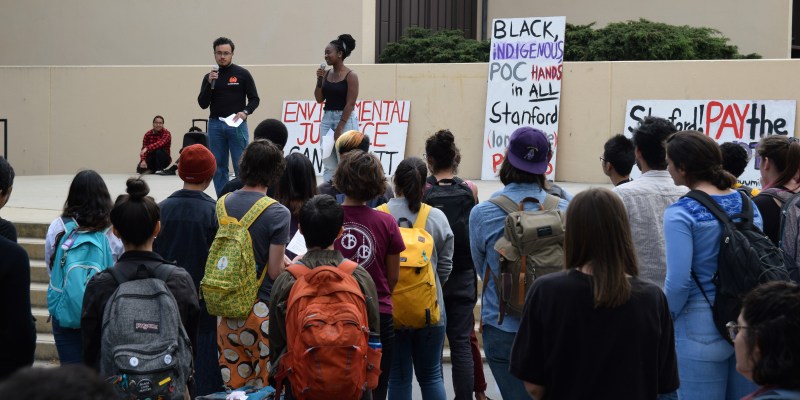Students walked out of classrooms across campus to rally for environmental and racial justice at Stanford on Monday.
The protest, led by the student organization Students for Environmental and Racial Justice (SERJ), emerged out of efforts to support a petition to hire five faculty focused on environmental justice. The petition was started through the efforts of the Environmental Justice Working Group, a group of staff, students and faculty with an environmental justice focus.
Students left their classrooms at 11:30 a.m. and met in White Plaza, gathering around tables with signage and information about the demands. Spencer Robinson ’20 said that SERJ has three demands for Stanford: hire five professors who do research specifically on environmental justice, pay the Shuumi Land Tax intended for non-Indigenous people living Chochenyo and Karkin Ohlone territory and center the voices of people of color in the University’s Long-Range Planning process..
Whitney Francis ’19, a member of SERJ who co-organized the event, said that the purpose of the walkout was to open a conversation about environmental justice at Stanford and create “a sense of urgency” about “why we need to act now on this.”
She added that the event has been a collaborative effort, weeks in the making. After Maya Burke ’18 MA ’19 proposed the event at the end of March, Francis said that SERJ “hit the ground running” in week one of spring quarter to make it a reality.
“Being complicit with the system is something we think Stanford should acknowledge,” Robinson said.
Students identifying as Indigenous, Black and people of color as well as representatives from the EarthTones festival, Fossil Free Stanford and the Institute for Diversity in the Arts, connected their work and identities to the need for environmental justice on campus.
“We are here to call the university to action on the issue of environmental justice pedagogy and faculty,” said Kory Gaines ’21 in his rally speech. “Natural disasters and other catastrophic events oftentimes hit marginalized communities hardest…Think Houston and Hurricane Harvey, think of incarcerated people who are paid very low wages to put out fires in Northern California.”
Stephanie Fischer ’18, a speaker at the rally, said that environmental justice is also about equal access to the benefits of the environment, and that the walkout was an effort in pursuit of that vision.
“We fight because we love…We’re here because we love a vision of having access to environment and resources,” Fischer said.
She added that much of the event has stemmed from the Earth Systems community, “which is really heartening.” The Earth Systems department launched its first course on environmental justice in Autumn 2018, taught by School of Earth writing specialist and PWR lecturer Emily Polk and Earth System Science researcher and instructor Sibyl Diver, both members of the Environmental Justice Working Group.
To The Daily, Fischer described environmental justice as “reconnecting with the past,” involving a “symbiotic relationship with the Earth and getting that love from the Earth.” In the modern context, Fischer said, that looks like anything from access to water to safety in natural places to affirmation that under-resourced communities have the support they need.
For Chester Thai M.S. ’19, who walked out of class to attend the event, environmental justice is about focusing on communities where there has been a “disproportionate impact” of environment-related harms, from land occupation to resource use and access.
“I think the biggest misconception is that [environmental justice] is a new movement,” Fischer said.
Maya Acharya ’20 echoed this sentiment in her rally speech.
“It wasn’t until I started learning about the histories of South Asia and its diaspora that I learned about the strong lineage of people who look like me working for these things at global and local scales,” Acharya said.
Jacob Wolf ’19, who said he came to “add another body to the cause,” said he saw the rally as a “shift in the conversation” from mainstream environmental campaigns that often emphasize small personal steps such as household electricity usage. “While those things are important,” he said they often make participants “feel good” about their participation without addressing underlying issues.
Gabriel Saiz ’21 emphasized the importance of environmental justice education in his rally speech. “We can at least start putting these ideas in people’s heads by hiring environmental justice faculty,” said Saiz. “Everybody on the stage today is multifaceted in the way they’re thinking about things. That’s the way changes are going to be able to be made.”
Around 12:30 p.m., Saiz and Burke led the participants past the roundabout colloquially known as the Circle of Death, along the quad, and to the center of Main Quad, chanting: “Whose land is this? Ohlone land…Black, Indigenous, POC hands, all over Stanford’s Long-Range plans.”
Following the rally, SERJ plans to focus its attention on The Shuumi Land Tax petition, which launched on Monday night.
“We’re hoping that part of this rally will really educate people on what that is,” said SERJ organizer Ayoade Balogun ’21. On a broader scale, Balogun said, “We definitely want to be an advocacy organization on campus…focused around action.”
Contact Elise Miller at elisejl ‘at’ stanford.edu.
